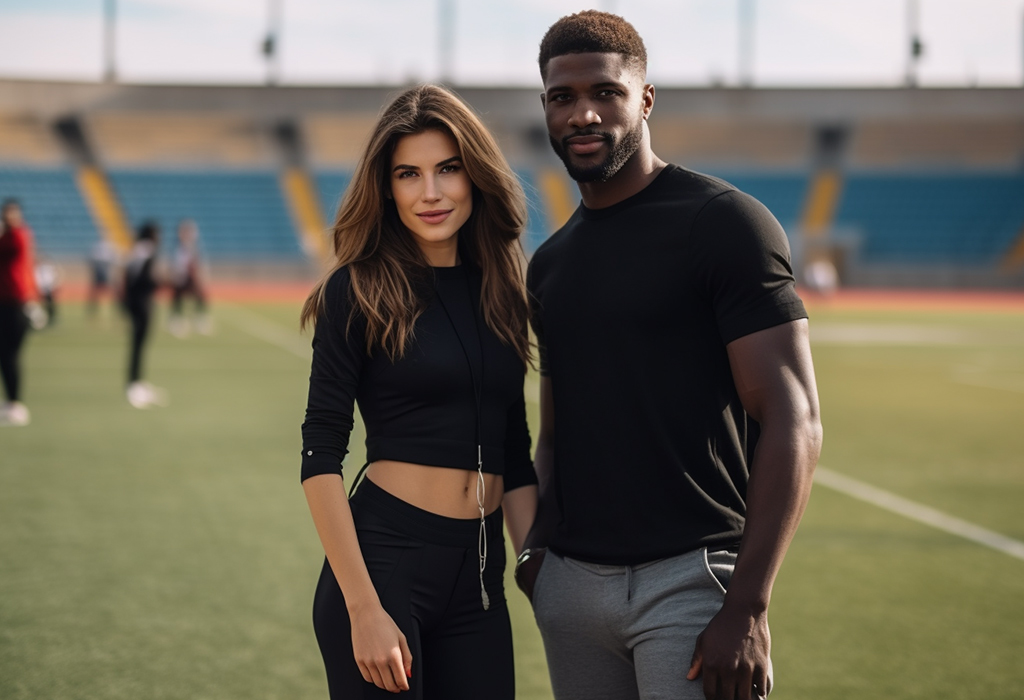
Broad shoulders and slimmer hips:
RIVALS. One study from 2001 examined whether high shoulder-to-hip ratio caused higher jealousy in males that considered themselves rivals.
They found that males that viewed potential rivals with high shoulder-to-hip ratios viewed them with greater jealousy and rated them as more attractive.
Females also viewed men with broad shoulders and narrow hips to be more attractive. Men with high shoulder-to-hip ratios were rated as more socially and physically dominant by rival males.

SUMMARY: Men with broader shoulders and a slimmer waist are perceived as more attractive, more confident/dominant, and more physically strong, and provoke stronger rivalry and jealousy in males who are potential rivals – an effect that can be leveraged in any business or social setting where a man wants to come across as more dominant and confident among potential rivals (like a job interview).
Reference: Dijkstra, P., & Buunk, B. P. (2001). Sex differences in the jealousy-evoking nature of a rival’s body build.Evolution And Human Behavior, 22(5), 335-341.
HORMONES. Men with broad shoulders and narrow waists were found to have more testosterone than those who don’t. This shows that there are probably unconscious cues that are being communicated by body configuration. Broad shoulders and narrow hips indicate greater hormonal masculinity.
SUMMARY: Strong shoulder-to-hip ratio communicates more masculinity because it indicates greater levels of testosterone.
Reference: Kasperk, C., Helmboldt, A., Borcsok, I., Heuthe, S., Cloos, O., Niethard, F., & Ziegler, R. (1997). Skeletal site-dependent expression of the androgen receptor in human osteoblastic cell populations. Calci?ed Tissue, 61, 464 – 473.
SEX APPEAL. Men with more wedge-shaped torsos (broad shoulders, narrow waist) have more sex partners and have sex earlier than men who don’t.

The take-away message here is obvious. It’s not just about perceptions, it’s also about strong mating success (whether you want to actually promote sleeping around is not my department, but suffice to say it shows that certain body styles have more sex appeal).
Reference: Hughes, S. M., & Gallup, G. G., Jr. (2003). Sex differences in morphological predictors of sexual behavior: Shoulder to hip and waist to hip ratios. Human Behavior and Evolution, 24, 173-178.
EVOLUTION: The evidence of body shape on sex appeal, human hormones, rivalry, and social dominance lead two researchers, Gordon Gallup (University at Albany, SUNY) and David Frederick (UCLA) to conclude that there are probably strong evolutionary factors at work in determining attractiveness and perceived fitness – exactly what you argue in your paper.
Reference: Gallup, G. G., Jr., & Frederick, D. A. (2010). The science of sex appeal: An evolutionary perspective. Review of General Psychology, 14(3), 240-250.
Symmetry
HEALTH: The research is permeated with studies that show that body symmetry is related to overall health.
This is because body symmetry relates to the person’s developmental course – an “uneven” developmental path relates to uneven physical development.

Thus, attempts to “correct” visual body symmetry will give an indication of better health, and health is attractive.
Reference: Weeden, J., & Sabini, J. (2005). Physical attractiveness and health in Western societies: A review. Psychological Bulletin, 131(5), 635-653.
Wealth and Attractiveness
MASCULINITY: This is by far the craziest study I found in my search. Three researchers in England in a recent (2013) study showed women a series of images corresponding to direct male-to-male competition, violence, or items with high monetary value (as opposed to peaceful scenes), and then asked them to rate the attractiveness of various masculine face traits.

What they found is that highly “masculine” faces were rated as more attractive after the women saw images of wealth and male-male competition. Yeah, that’s right – images of wealth, and competition, caused masculinity to be more attractive.
What does that mean? Having a wealth-related item (such as a nice watch) can actually enhance your masculine features and make them seem more attractive to women.
This means that fashion that enhances masculine traits, combined with items that indicate wealth, causes a “double-whammy” effect.
Reference: Little, A. C., DeBruine, L. M., & Jones, B. C. (2013). Environment contingent preferences: Exposure to visual cues of direct male–male competition and wealth increase women’s preferences for masculinity in male faces. Evolution And Human Behavior, 34(3), 193-200.